If you want to know about the acoustics in auditorium or acoustics in cinema or acoustics in landscape, please click the link.
Acoustics is the branch of physics that deals with the study of sound and its properties, behavior, and production. It involves the study of how sound waves travel through different materials and how they interact with each other and their environment.
In architecture, acoustics is an essential element in the design of buildings and spaces that require good sound quality, such as concert halls, theaters, lecture halls, and places of worship. The goal is to create an environment that allows sound to be heard clearly and accurately while minimizing unwanted sounds and echoes.
- Acoustics is derived from a greek word akouo, which means to hear. Acoustics design is an essential in architecture these days. Due to increased noise pollution, it has become essential to insulate the buildings from noise and also to create an acoustical environment.

- An acoustical environment consists of a source, a medium for transmission and a receiver. The quality of acoustical environment also greatly depends on the above three factors.
1) Terminologies
- Sound wave: the propagation of the sound through compression and rare fraction in an elastic medium.
- Source: the originator of a sound vibration.
- Spectrum: data including frequency, pressure and level of complex sound.
- Speed of sound: 344m/s; 1130ft/s in air at room temperature.
- Spherical divergence: spherically spreading of sound from a point source in free space.

- Tone: pure sound, sine wave.
- Wave lenght: distance between two peaks of a sound wave, or distance a wave travels during one cycle.
- Absorption: transformation of sound energy into heat
- Absorption coefficient: fraction 0f sound energy absorbed by a surface
- Anechoic: without echoes
- Anechoic chamber: room allowing no reflections for acoustical testing and measurements
2) Science of sound
- Sound is a physical disturbance (vibration) of molecules within a medium capable of being detected by a normal ear.
- Sound has a wave nature. It has its origin in vibrating bodies and it needs a medium for propagation. Sound cannot travel through vacuum.
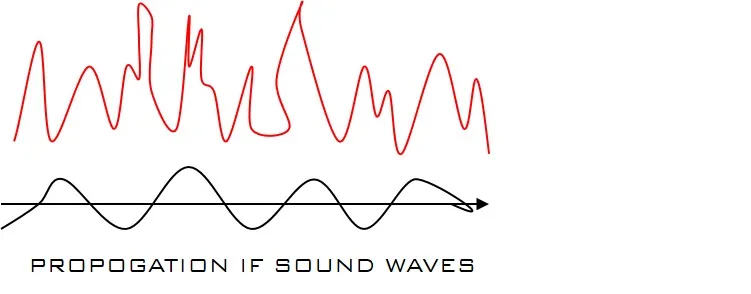
i) Wave motion
- Particles in a medium such as air or water, vibrate about their equilibrium position, receive momentum from collisions and pass it on to other particles thus propagating sound waves. This movement of particles propagating sound is called the wave motion.
- Sound waves are propagated through alternating compressions and rarefactions.
- The vibrating particles do not change their average position if the transmitting medium itself is not in motion.
- White noise is random sound with its energy distributed evenly and uniformly throughout the spectrum. Its amplitude is constant across different frequencies, similar to white light. It generally sounds like tape hiss.

- Pink noise is also random sound, but with its energy concentrated more in the lower frequencies. It can be compared to red light. Pink noise has the same power within each octave. It sounds more pleasant than white noise, like rushing water.
3) Human sensitivity to sound
- The two main aspects of human hearing are the physiology of the auditory system, and the processing of sound information in the brain.
- The resulting perception of sound is not easily measurable and does not always relate to physical events in a linear fashion.
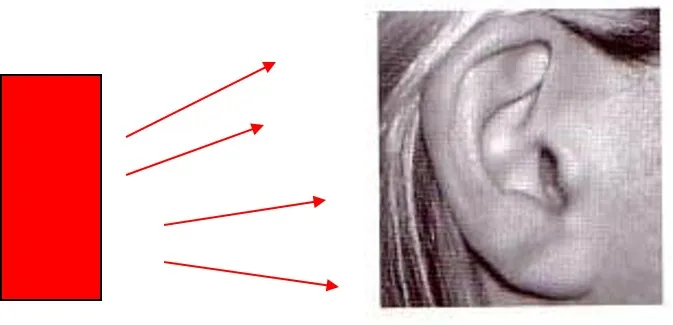
i) Perception
- Psycho-acoustics is concerned with the perception of sound. It is not an isolated discipline, but is closely interconnected with psychology, physiology, biology, medicine, physics, music, engineering, architecture and other fields. The relative and subjective nature of perception and the complexity of the involved processes are the subjects of much ongoing research.
- Human hearing and perception is a complex and highly evolved system. It can detect a wide range of stimuli and identify them by pitch, timbre, loudness and location.
4) Superimposition of sound waves
- The property of sound by which sound waves traveling in opposite directions can pass through each other and emerge in their original condition is called superimposition of waves
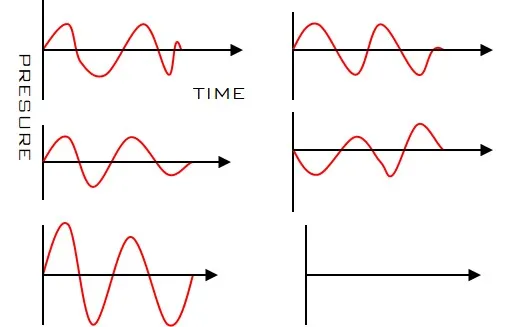
i) Interference
- Two or more waves may support each other through constructive interference, or cancel each other (destructive interference).
- A large number of different sound waves traveling in different directions can be superimposed in space, and can still be detected as distinctive from one another.
5) Types of sound waves
- Periodic sound waves are regularly repeated pattern of oscillations. A sine wave is the simplest form of a periodic wave, representing a pure tone at one single constant frequency, while they do not exist in nature, sine waves can be generated by electronic equipments.
- Aperiodic sound waves (noise) have no periodic frequency or oscillations. They are technically referred to as noise. If the noise is concentrated in a narrow range of frequencies, it is called tonal noise.

- The average maximum distance the individual particles are moved from equilibrium position is called the displacement amplitude.
- The velocity with which the particles move back and forth about their equilibrium positions is called the particle velocity.
- The complete to and from motion that a particle makes in 1 sec. Is called the frequency of vibration. It is a physical phenomenon.
6) Physiology of hearing
- The ear is divided into three parts: the outer ear, the middle ear and the inner ear. Each fulfills a distinctive function, from gathering sound to forwarding information to the central nervous system.

i) The outer ear
- The pinna, or external ear, reinforces and directs sound into the ear canal. Its particular shape acts as a comb filter, whose frequency response helps with the localization of sound sources, especially of higher frequencies.
- A resonating pipe, the ear also reinforces sonic energy. Its resonant frequency lies around 3khz, the frequency range to which humans are most sensitive.
7) Health issues
- Upper frequency hearing naturally diminishes with age. Long term, or repeated, exposure to intense sound levels, occupational or recreational, can cause permanent damage at all ages.
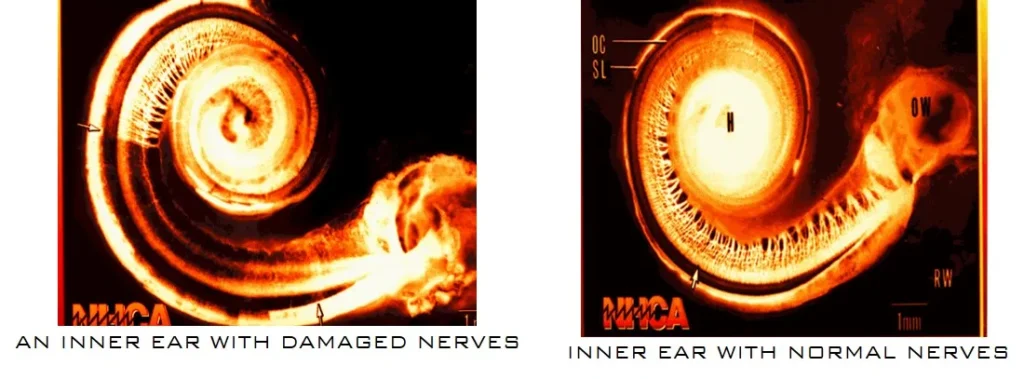
- Health regulations govern both the loudness level and time of exposure per day. Music industry and medical groups are concerned with the protection of musicians, audio professionals and audiences.
8) Pitch
- Pitch is the subjective perception of frequency, the characteristic of a sound that makes it sound higher or lower, or that determines its relative position on a scale. For pure tones,
- Pitch is determined mainly by frequency, but also by sound level. The pitch of complex sounds also depends on the timbre of the sound and its duration.

- Absolute pitch is the ability to recognize the pitch of a tone without the use of a reference tone.
- Less than 0.01 percent of the population have this ability. Most people have a degree of relative pitch recognition, the ability to tell whether a tone is higher or lower than another.
9) Loudness
- The relationship between sound pressure levels and loudness perception is not linear. Equal loudness contours show the average perception of loudness of a large number of test subjects. Sounds with the same perceived loudness level have the same phon value.
- The curves indicate that hearing sensitivity diminishes greatly at lower frequencies, and that the greatest sensitivity lies in the area of speech frequencies.
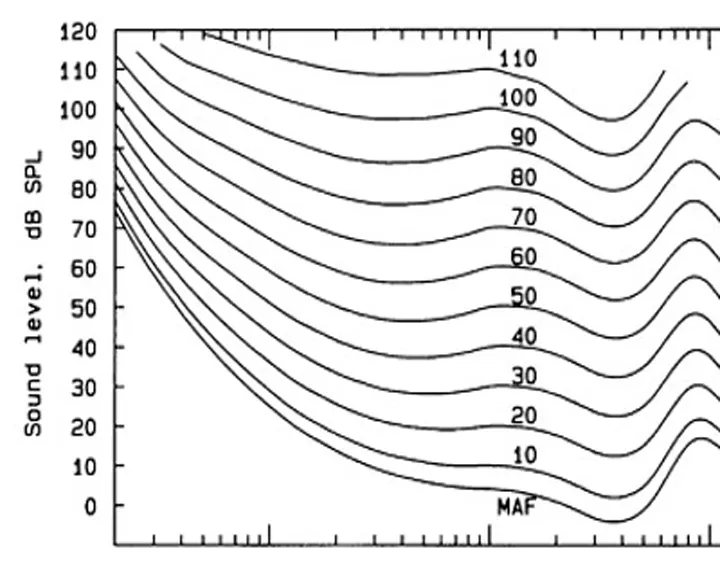
- Human hearing occurs between two threshold curves: the threshold of hearing is the minimum audible limit, whereas the threshold of feeling is indicating the beginning of the sensation of pain.
- The area of audibility between the two curves includes yet smaller subsets for the ranges of music and speech.
10) Reverberation and echo
i) Reverberation
- Reverberation is inversely proportional to the amount of sound absorbing material in a space. More absorbing material results in less reverberation.
- Reverberation time is frequency-dependent and needs to be checked for each octave band. Different room uses require different reverberation times.
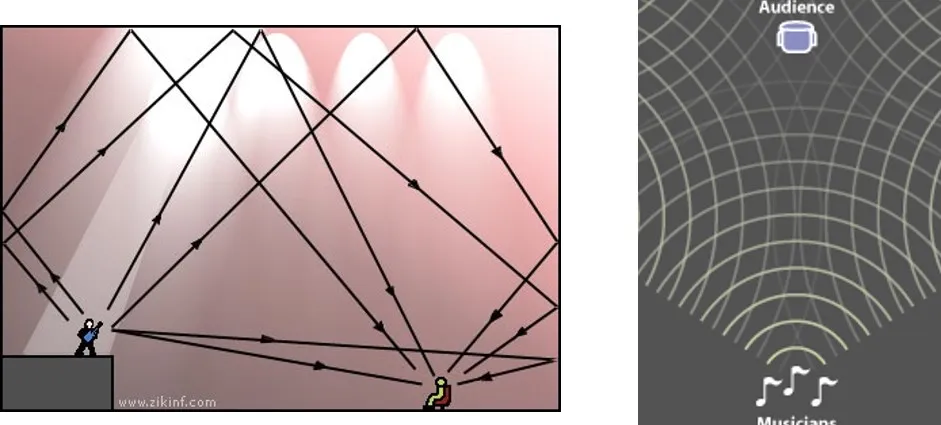
ii) Echo
- Sound is a waveform made from vibrating matter. The sound wave travels through matter–especially air–in a straight line. When the wave hits a different material, some of it is reflected, absorbed and transmitted through the material. In the case of a sound wave in air hitting a solid wall, most of the sound is reflected back.
- If the wall is relatively flat, perpendicular to the source of the sound, and far enough away (but not too far), then the person can hear the reflected waveform or echo.
Overall, acoustic design is an important aspect of architecture that can greatly enhance the experience of occupants and visitors by creating a space with high-quality sound and minimal noise.